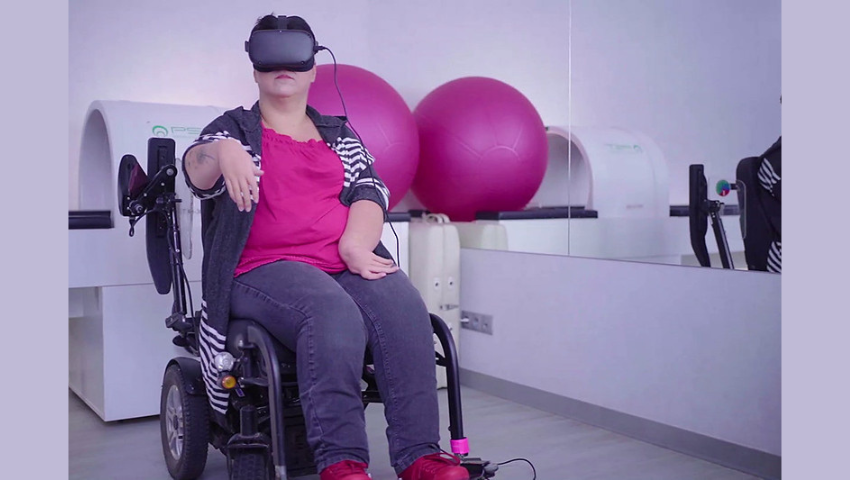Image Credit: Image courtesy of WalkinVR
This ACM SIGGRAPH Blog feature dives deep into the special benefits of virtual reality and how they can be extremely useful in the realm of healthcare. Virtual reality can be used in the medical industry for a variety of purposes, from offering pain relief without the need of medicines to facilitating novel group therapy sessions. Here, through the lens of “WalkinVR,” this SIGGRAPH 2022 Educator’s Forum team further discusses how increased accessibility can benefit people who stand to gain the most from the benefits of VR.
SIGGRAPH: You have found that immersive media can change lives in more ways than one. What, in your team’s opinion, is the greatest way immersive media can help others, and why?
Yetsa Tuakli-Wosornu: Immersive environments ignite our innate joy of exploration, which can spark profound cognitive, emotional, and perceptual broadening. By shifting us into curiosity and learning states, immersive media opens us up to the possibility of taking another perspective, walking in another person’s or group’s shoes, and sensing the world from an unexpected point of view. In this way, immersive media can drive empathy between diverse groups of people. This deeper level of perceptual learning can foster the compassion, understanding, and social cohesion we need to take care of each other in the real world.
SIGGRAPH: This panel’s goal was to discuss how expanded accessibility offers unique benefits to populations who have the most to gain. What inspired your interest in this space?
Greg Bednarski: I have created a functionality that was later basis for “WalkinVR” for my sons when they were kids and too small to play VR. When I was testing, I realized that this functionality can be used by people who are in wheelchairs to move and rotate around the VR space. I created “WalkinVR” so everyone could use it. After that, I got lot of feedback for people with other conditions like limited hand movement (e.g., SMA), no ability to hold controllers (e.g., CP), and others.
SIGGRAPH: The COVID-19 pandemic has secluded people from their family, friends, and even work. How does this technology help people who are struggling with loneliness and isolation?
Asher Marks: The real value in VR, when it comes to seclusion and isolation, is the ability to simulate a shared space when using social VR interventions. Even in the age of Zoom meetings and easy FaceTime calls, there is still a sense of lack of presence, of talking to a screen. With social VR we have the opportunity to once again share a communal space with loved ones and friends — even in a time of necessary isolation or limitations on travel.
SIGGRAPH: What do you hope future generations take away from immersive media in healthcare? What do you hope to see accomplished?
Kimberly Hieftje: I think we need to provide our current high school, college, and graduate students with more hands-on opportunities early on to explore how immersive media is working to solve complex problems in health and medicine. We need to actively support and encourage the next generation of innovators and critical thinkers, as they will be taking the baton from us and creating things we can only dream of right now.
SIGGRAPH: What, in your opinion, is the next big technology in healthcare, and how will this benefit others’ lives?
Justin Berry: I think that the most powerful feature of emerging media is not found in the highly produced and industrial focused devices or applications, but rather in the expanding set of free, professional quality, media production options. As the ability to create custom solutions extends from an expensive project requiring experts to something a patient can do on their own at home, such as using Indistinguishable From Magic’s device to create custom adaptive interfaces or Unity to create their own imaginary worlds. As solutions become accessible to individuals and smaller target groups, those solutions become inherently more diverse and serve increasingly diverse populations.
SIGGRAPH: What advice would you give to someone planning to participate in a future SIGGRAPH Educator’s Forum session?
Team: Do it! The opportunity to engage with your peers and the remarkable community of people who composes SIGGRAPH is invaluable for getting the feedback and critique required to deepen your own efforts. It is also extremely important for those of us working in new frontiers to share and disseminate the insights we gain from our sequestered efforts to contextualize our successes and failures.
SIGGRAPH 2023 submissions are now open! Programs like Educator’s Forum, Technical Papers, VR Theater, Immersive Pavilion, and more are accepting contributions to be considered for the 50th SIGGRAPH conference. Submit now.



